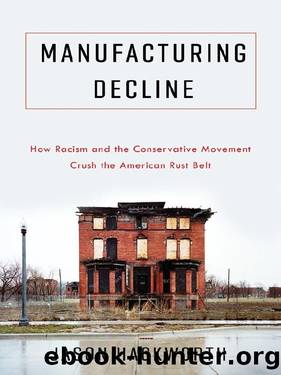Manufacturing Decline: How Racism and The Conservative Movement Crush The American Rust Belt by Hackworth Jason

Author:Hackworth, Jason [Hackworth, Jason]
Language: eng
Format: epub
Tags: SOC031000, Social Science/Discrimination & Race Relations, HIS036090, History/United States/State & Local/Midwest
Publisher: Columbia University Press
Published: 2019-01-10T00:00:00+00:00
To get the neighborhoods going, we’ve got to take down the 78,000 or so—we don’t even know the exact number of structures that need to be taken down, mostly houses. Once we can get that done, you will have open pieces of land, and you’re going to have, more importantly, hope and optimism….32
Demolition is increasingly seen as a stand-alone policy necessary to unleash the equilibrating tendencies of the market and the ostensibly community-stabilizing benefits that follow. As a recent New York Times piece on the subject put it, “For a number of American cities in the Northeast and Midwest that have lost big chunks of their population, [demolition]…is increasingly regarded as a path to salvation.”33 Ad hoc demolition has moved from defensive local maneuver to an ostensibly generative policy vehicle in and of itself.
A number of scholars have, conversely, expressed grave concern with the assumption that demolition will improve the problems associated with such neighborhoods without some other form of intervention. First, some scholars argue that the putative connections between physical deterioration and social disorder are spurious or overstated. Mike Benediktsson, for example, argues that the actualized relationship between vacancy and disorder is socially constructed rather than physically predetermined based on a level of blight and dependent on intracommunity relationships and other social filters.34 In particular, researchers have found that respondents see more blight when black people are present in images of urban distress.35 Second, some have suggested that demolition may actually accelerate rather than slow processes of disinvestment.36 By applying the highly problematic logic of triage to neighborhoods or houses, planners risk accelerating the underlying process when they label something as beyond hope.37 Demolition is perhaps the clearest signal a city could send that a neighborhood has been left for dead within this troubling triage analogy—a signal that rapidly becomes a self-fulfilling prophecy.38 Third, some have drawn upon the almost universally criticized urban renewal experience to suggest that the demolition model did not work then and should not be replicated even if the underlying justifications for past and current programs are marginally different. Hollander and Nemeth have argued, for example, that current demolition plans threaten to replicate the top-down planning flaws of the urban renewal period.39 Others argue that urban renewal’s demolition focus did indeed change the landscape but not in a way that improved neighborhood livability or the lives of poor people.40 Finally, even two recent hedonic modeling studies that are frequently cited to promote the demolition approach point to real limitations.41 Both studies do indeed find a negative relationship between house values and proximity to a vacant house, but both also find a (smaller) negative relationship between house values and the proximity to a vacant lot. In the more sophisticated of the two studies, researchers also found that while the relative gains in property value justify the expense of demolition in middle-class neighborhoods, the costs of demolition exceed the potential benefit of property-value gain in more distressed areas (i.e., EHLNs).42
In short, serious, carefully articulated, empirically grounded concerns
Download
This site does not store any files on its server. We only index and link to content provided by other sites. Please contact the content providers to delete copyright contents if any and email us, we'll remove relevant links or contents immediately.
| General | Discrimination & Racism |
Nudge - Improving Decisions about Health, Wealth, and Happiness by Thaler Sunstein(6629)
iGen by Jean M. Twenge(4692)
The Fire Next Time by James Baldwin(4336)
Adulting by Kelly Williams Brown(3662)
The Sports Rules Book by Human Kinetics(3580)
The Hacking of the American Mind by Robert H. Lustig(3575)
The Ethical Slut by Janet W. Hardy(3494)
Captivate by Vanessa Van Edwards(3292)
Mummy Knew by Lisa James(3163)
In a Sunburned Country by Bill Bryson(2940)
Ants Among Elephants by Sujatha Gidla(2919)
The Worm at the Core by Sheldon Solomon(2910)
Suicide: A Study in Sociology by Emile Durkheim(2605)
The Slow Fix: Solve Problems, Work Smarter, and Live Better In a World Addicted to Speed by Carl Honore(2570)
Humans of New York by Brandon Stanton(2376)
Handbook of Forensic Sociology and Psychology by Stephen J. Morewitz & Mark L. Goldstein(2376)
Blackwell Companion to Sociology, The by Judith R. Blau(2313)
The Happy Hooker by Xaviera Hollander(2271)
Outliers by Malcolm Gladwell(2254)
